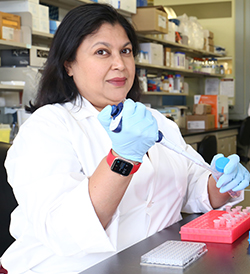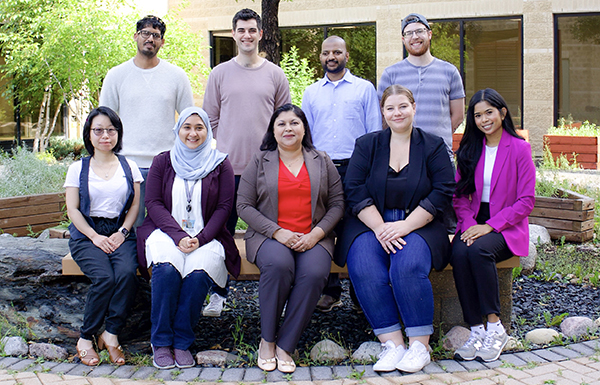Moving Beyond a One-Size-Fits-All Approach to Asthma Therapy
A special feature for Lung Health Month

Dr. Mookherjee in her lab
Research into the causes, prevention, management, and rehabilitation of the lungs and the respiratory system is one of the major health mandate areas for the Institute. Each November provides an opportunity to reevaluate our strategies for improving lung health, especially for those living with lung disease and other respiratory conditions. This Lung Health Month, I sat down virtually with Dr. Neeloffer Mookherjee, whose research is funded by CIHR, to talk about her work.
Dr. Mookherjee is a Professor in the Departments of Internal Medicine and Immunology at the University of Manitoba, and a CIHR Sex and Gender Science Chair in Circulatory and Respiratory Health. Her research on asthma has a focus on gaining a better understanding of the molecular processes of chronic inflammation and infection control in the lungs.
Below are excerpts from our conversation.
What is your message to Canadians for Lung Health Month?
I would encourage everyone to be mindful of the complexity of biology. We understand little pieces of the puzzle—we learn more every day. However, there is no simple solution to such complicated problems.
How does that relate to your research on asthma?
The lung inflammation that occurs in asthma is a complex process, and it affects people differently based on the quality of the air they breathe as well as the sex of the individual, in other words, whether they are male or female.
For example, if you have wildfires and particulate matter increases in the air, our research has shown it has a direct impact on immune responses in people who have asthma and whose lungs are impaired.
Our research is also looking at how responses to allergens and air pollution differ between males and females. This is important because we now understand that the immune system is wired differently between males and females. Our research will enable us to predict the progression of disease and response to therapy in a sex-specific manner because a one-size-fits-all approach does not really work in chronic inflammatory diseases.
You are exploring inflammation responses at the molecular level. Can you expand on that?
My lab group is working to understand how environmental exposures such as common allergens or air pollution change the proteins and disease processes in the lungs. By looking at how panels of proteins change in the blood and lungs in response to environmental allergens and pollution, we hope to be able to predict disease progression, severity, and response to therapy.
Furthermore, our lab studies a family of molecules known as host defense peptides. These molecules were originally known as antimicrobial peptides, and traditionally, many researchers focused on their antimicrobial activity. Over time, my lab and others have shown that these molecules play a complex role in the immune response. In particular, we have shown that these molecules regulate inflammation in the lungs. This is a fascinating family of molecules for me because the peptides have dual function: on one hand, they control inflammation, on the other hand, they control infections.
What is the goal of your research?
The overall goal is to understand the function of these peptides and use that knowledge to design therapy that can control inflammation in the lungs, for example, in asthma, without compromising the patient’s ability to resolve infections.
It is interesting because you have a platform that might be applied to several different diseases. The gut with inflammatory bowel disease, the joints with rheumatoid arthritis, the lungs with asthma, all sorts of things.
Our research on these host defence peptides may help us come up with new intervention strategies for many of these diseases. Something that I am excited about is that our latest research shows that these peptides have the potential to benefit patients who have severe asthma and those who do not respond to available therapies such as steroids. These discoveries could benefit Canadians and people globally.
You received a CIHR Sex and Gender Science Chair in Circulatory and Respiratory Health. How has that affected your career?
It has been a big honour. The Chair has significantly expanded the scope of my research program. We know that sex is a variable affecting our immune system, but for many years, this aspect was largely neglected in biomedical research and drug development.
Receiving this Chair funding has enabled me to integrate the fundamental components of sex and gender-based analysis in all my research projects, including in the projects and programs of my collaborators, both nationally and internationally. One of the key components of this Chair role is capacity building. I have been able to promote the importance of sex and gender-based science in biomedical research to our larger scientific community.
Next year I am organizing a new conference to promote the use of sex and gender analysis among the scientific community.
How does your own gender identity influence your perspective and your approach to your research?
I am an immigrant woman. I came to Canada from India to pursue my graduate studies. In my training in Canada, I have had many wonderful mentors—but I had no women mentors. It made me realize there is a lack of women role models and leaders, especially women who look like me in the biomedical science field. This has led me to champion the establishment of a women in science initiative called WISDOM at my university. It has enabled me to make valuable contributions to research, training, mentoring, and mitigating some of the barriers for women in science.
That’s phenomenal. In our clinical and academic ecosystem, we now have many women in leadership positions, so it has been a real transformation. There is still a gender gap between associate and full professor even after much progress. We continue to see that qualified women do not necessarily apply for our awards.
That is where I think we need to have some support systems in place, in the leadership areas, to encourage women scientists to progress in their careers.
What are some of the barriers, or bumps in the road that you come across as a mid-career scientist?
There have been many roadblocks, in my early career, and even now. I try not to get discouraged by failures. I have tried to use discriminations to fuel my conviction to do better in my career. A solid support system at home helps. Now, at the mid-career stage, one of the biggest challenges is getting requests for my time and assistance from many sources. I try to have good time management and to prioritize my commitments. Most importantly, I want to maintain my curiosity because that is what drives my love for science and research.
What would you say is the most rewarding aspect of your work?
Mentoring! I have the opportunity to mentor and teach students at different stages of their career. Education and knowledge transform lives and minds.

Dr. Mookherjee and her lab group at the University of Manitoba
That is fantastic.
Thank you to Dr. Mookherjee for this fascinating discussion; we appreciate your time and your commitment to science. I’d like to extend my best wishes to you and your team for continued research success. Finally, to everyone else, please reflect on how we can work together to improve health and wellness during Lung Health Month!
Sincerely,
Dr. Brian H. Rowe
Scientific Director, CIHR Institute of Circulatory and Respiratory Health
Professor, Department of Emergency Medicine and School of Public Health
College of Health Sciences, University of Alberta
More Information
- Date modified: